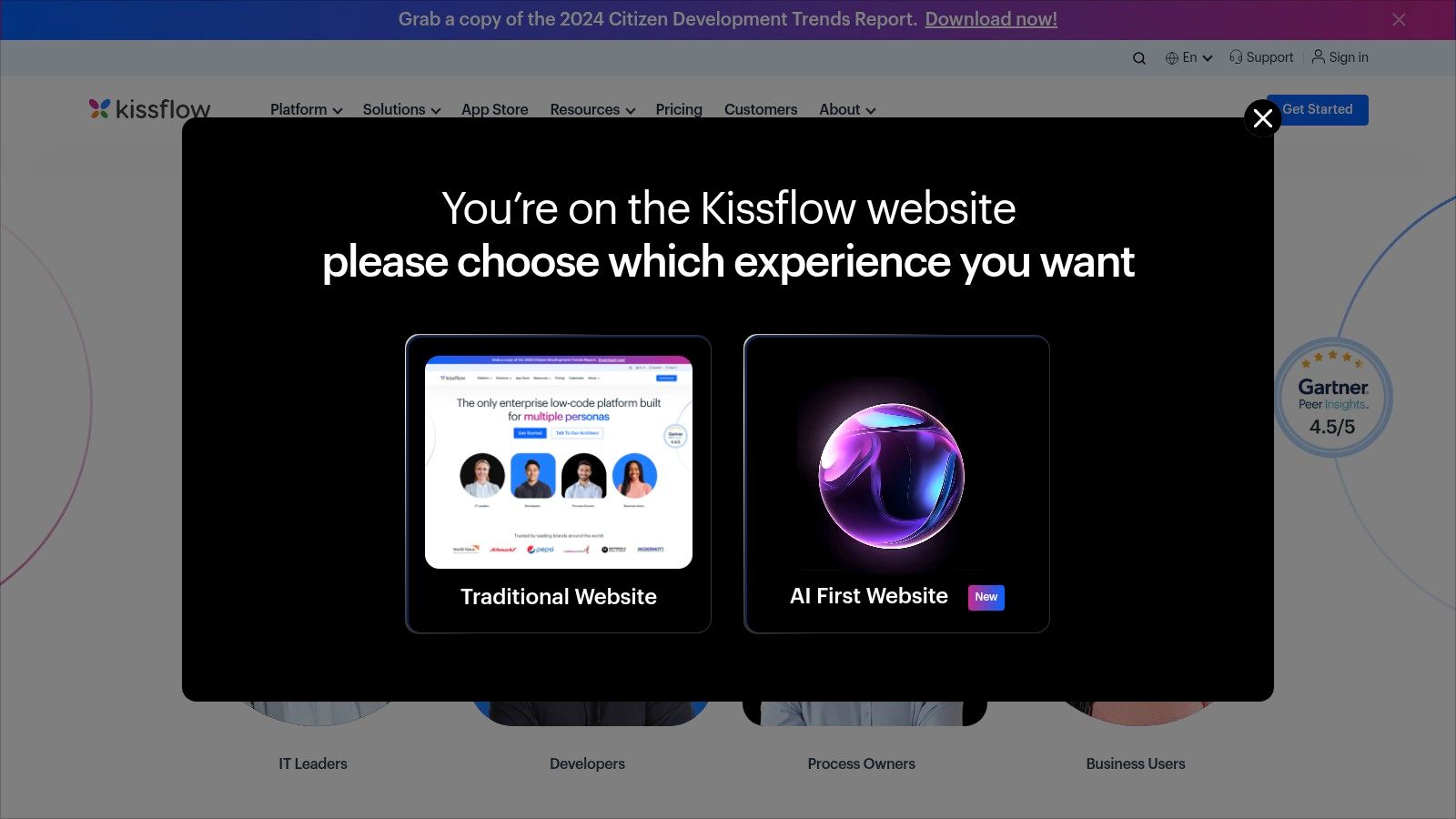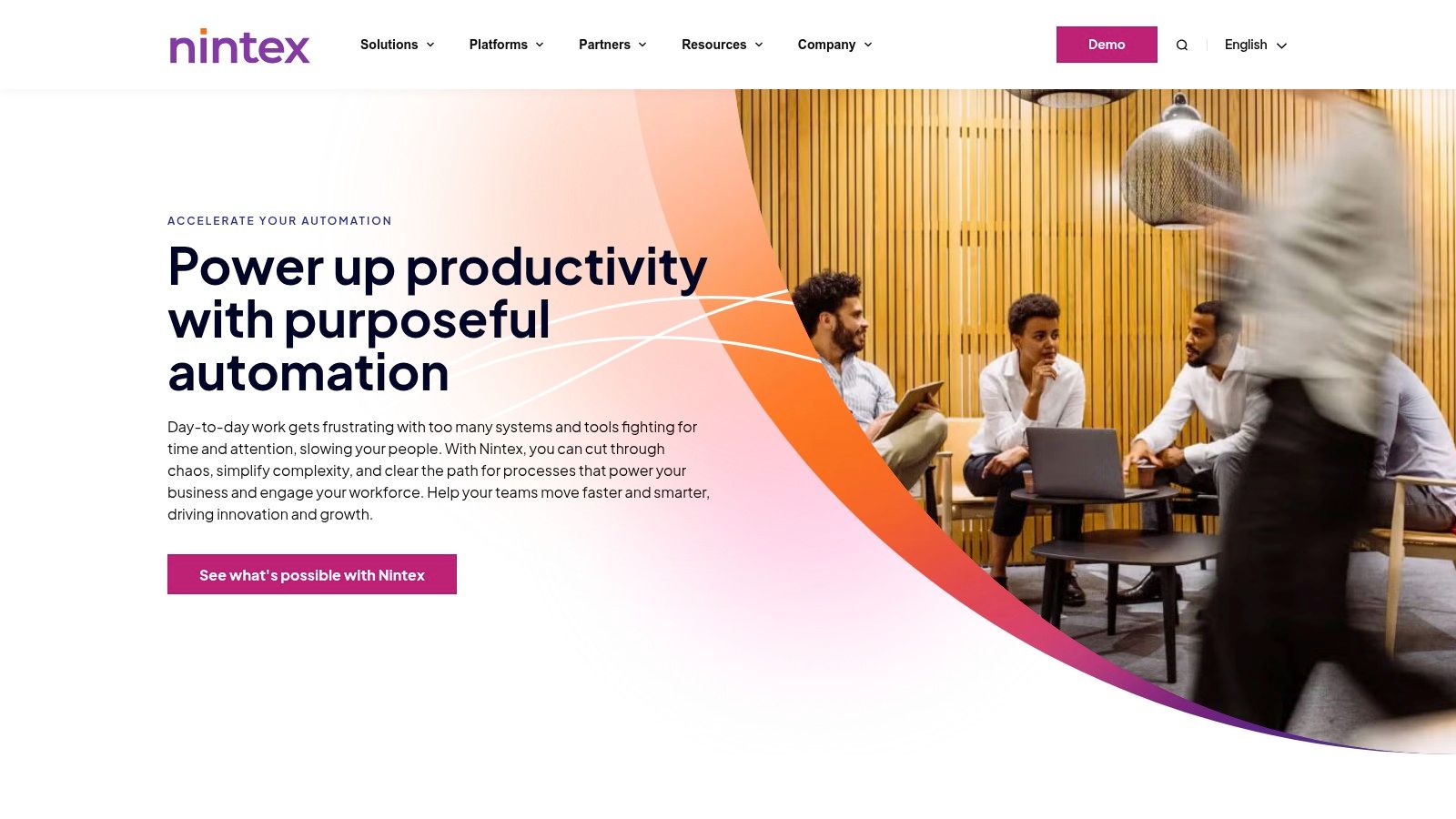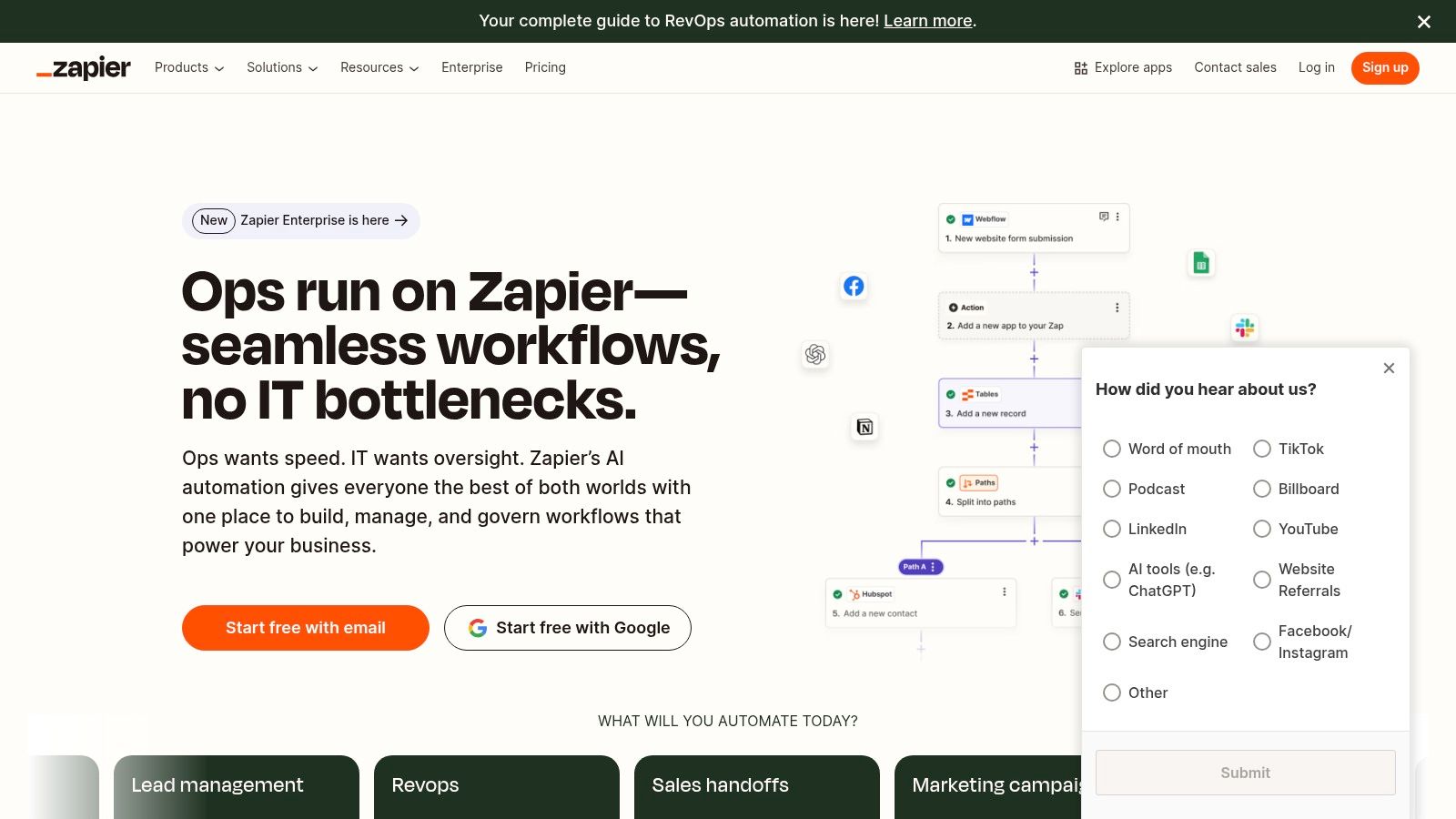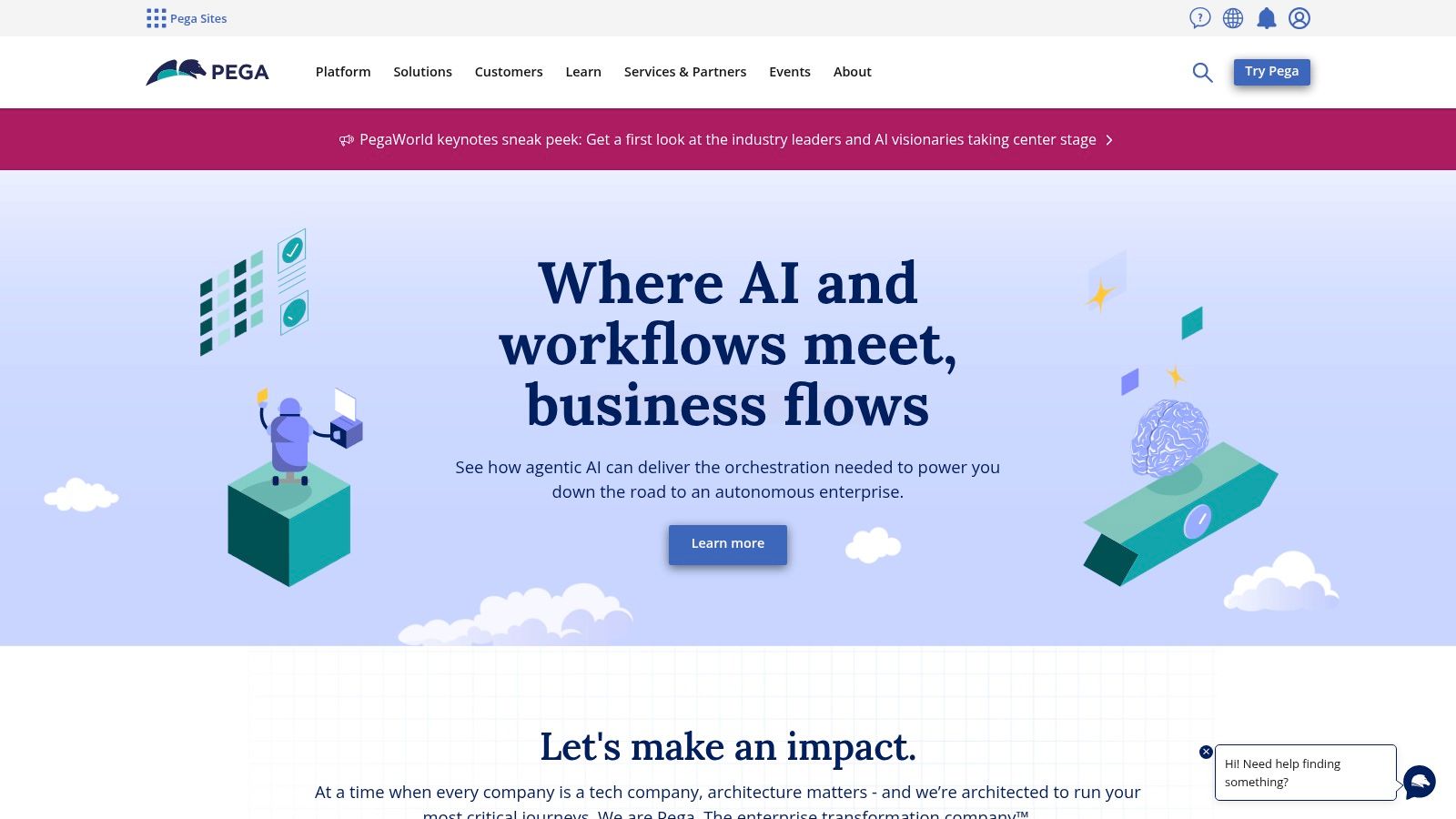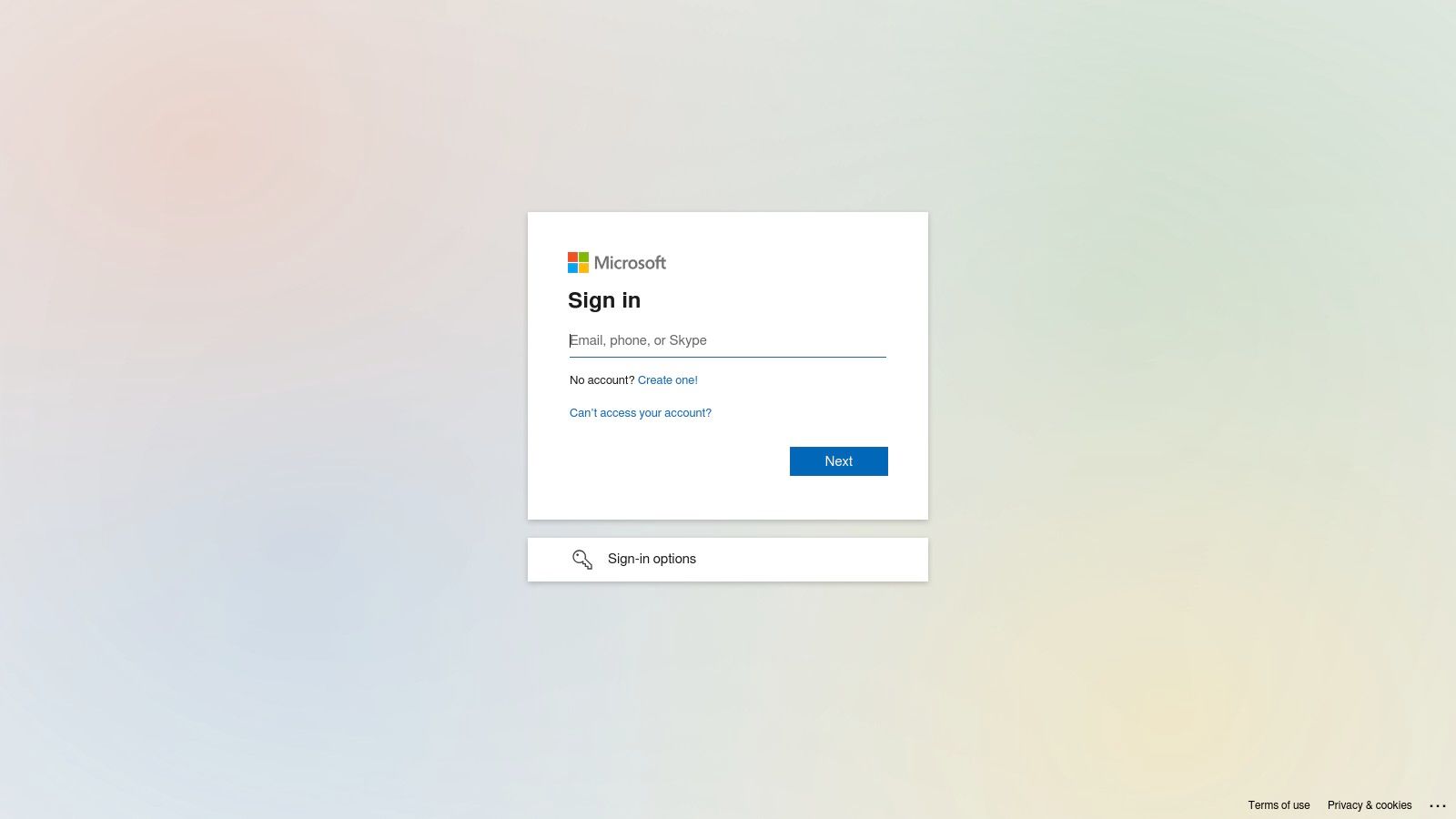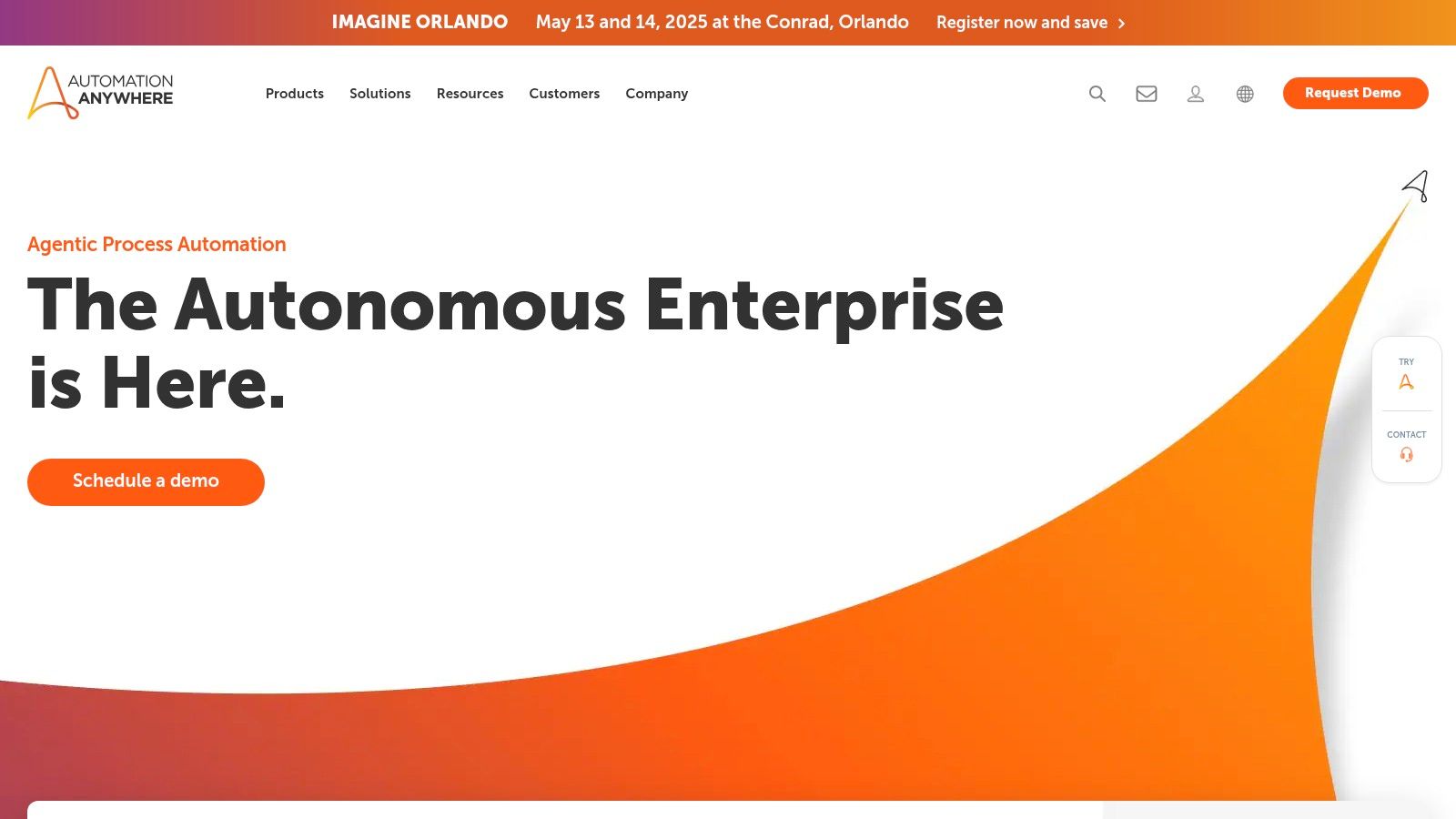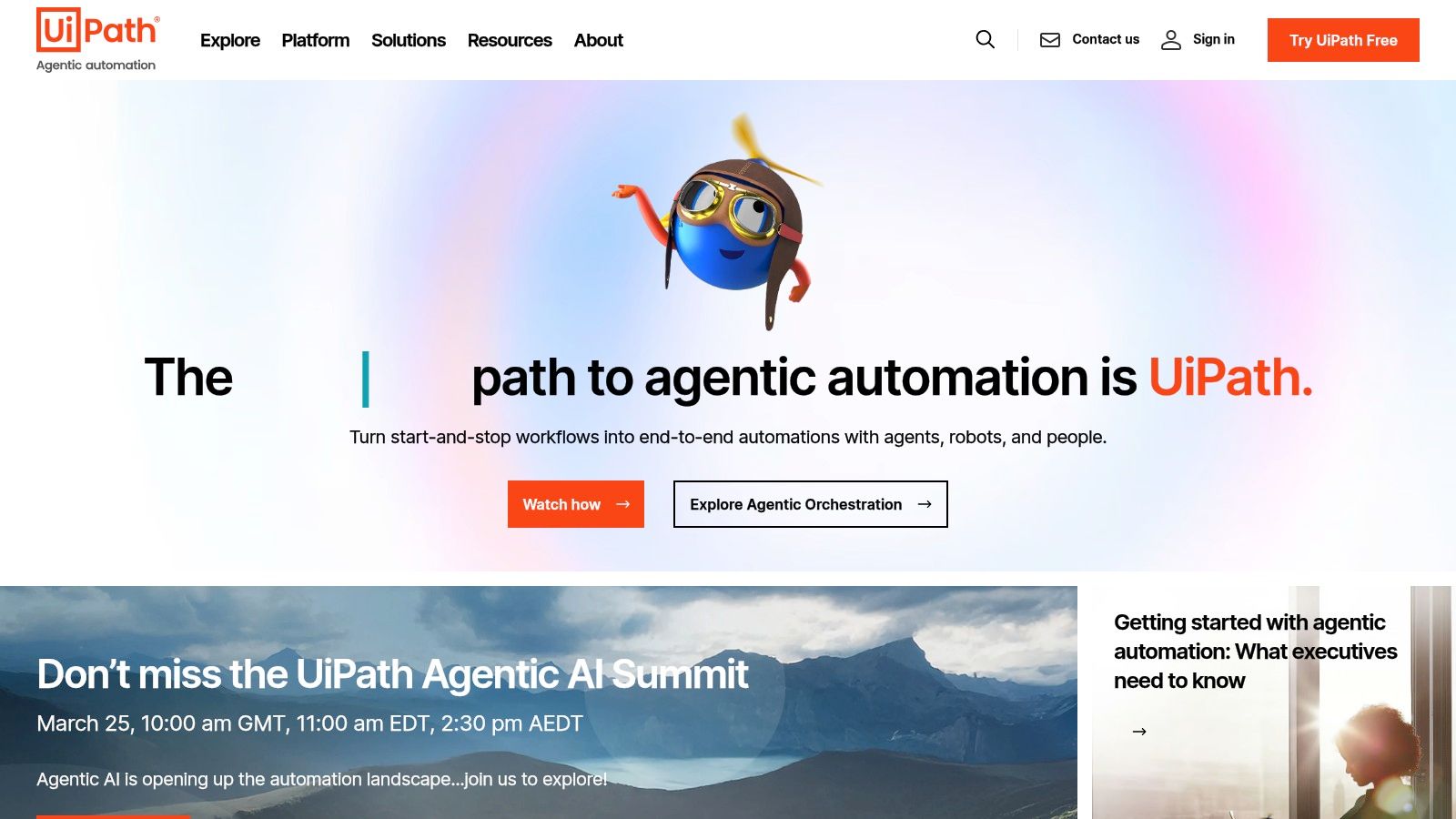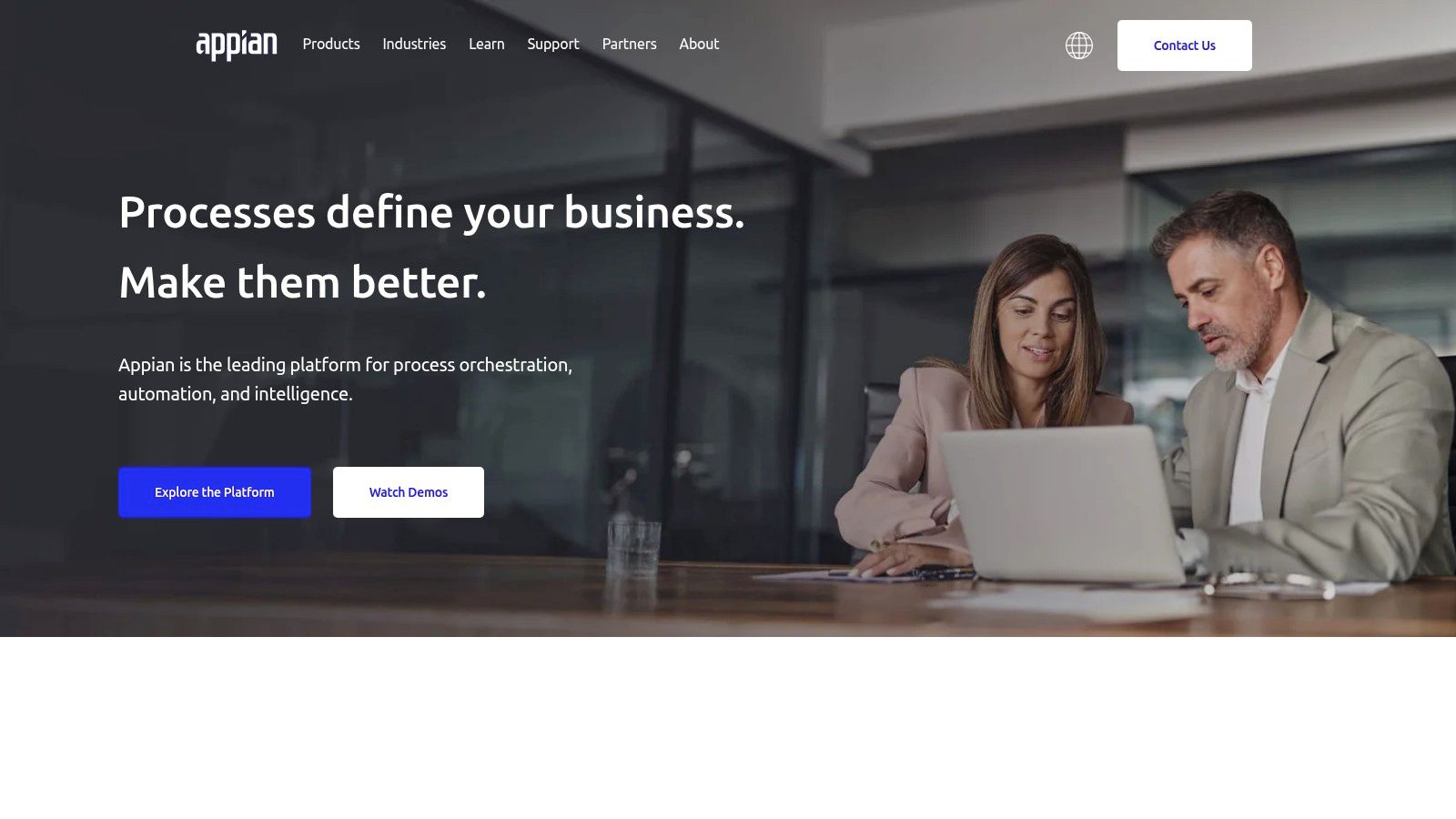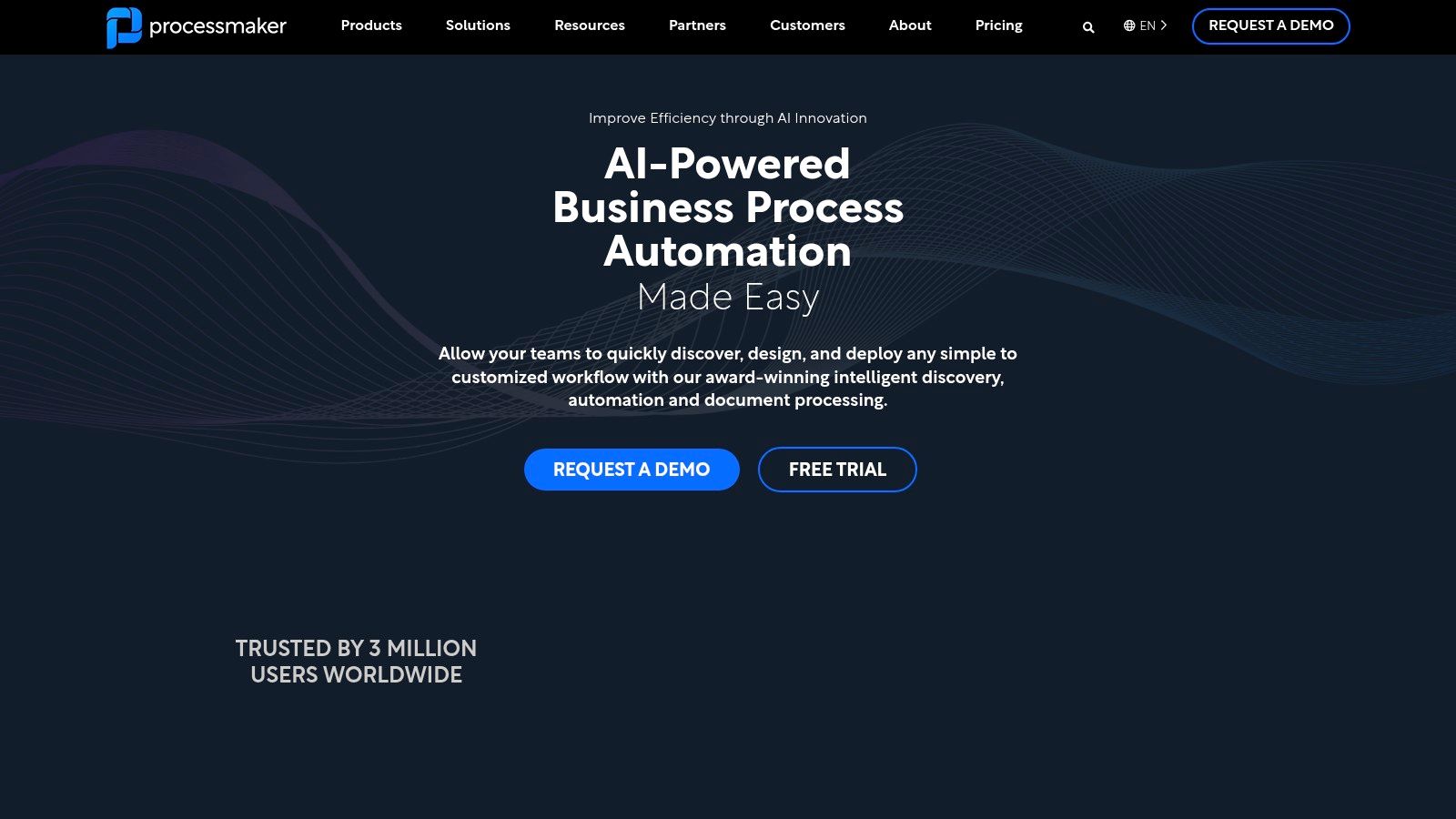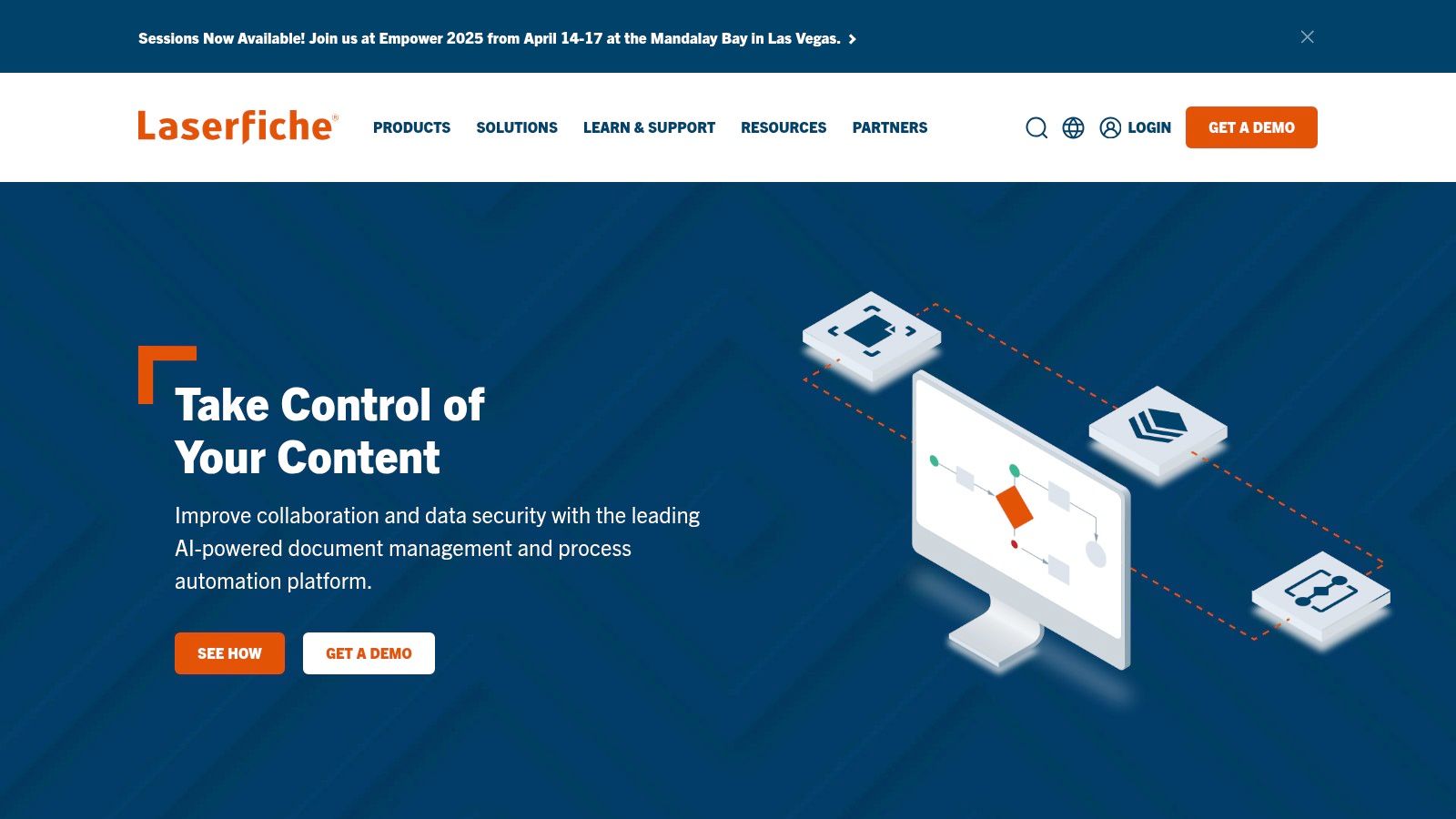Elevate Your Business With Automation
In today's fast-paced business environment, optimizing efficiency is critical. This is where Business Process Automation (BPA) comes into play. Are you overwhelmed with repetitive tasks like data entry, invoice processing, or email marketing? Perhaps you’re struggling to manage complex workflows and approvals. BPA software offers a powerful solution to these common challenges, freeing up valuable time and resources so your team can concentrate on what truly drives your business: growth and innovation.
Automating tedious processes allows you to reduce errors, improve compliance, and significantly boost productivity. However, selecting the right BPA software requires careful consideration.
Key Factors in Choosing BPA Software
- Workflow Complexity: How intricate are your current processes?
- System Integration: Does the software integrate seamlessly with existing systems like your CRM and ERP platforms?
- Scalability: Can the software grow with your business?
- Budget: What’s your allocated budget for BPA?
An effective BPA tool should offer a user-friendly interface, robust features (including Robotic Process Automation (RPA) and intelligent Business Process Management (iBPM) capabilities), and top-notch security to protect sensitive data. Pricing models vary, from subscriptions to perpetual licenses, often based on the number of users or automated processes. Deployment models, such as cloud-based versus on-premise solutions, also play a crucial role in selecting the ideal fit for your organization's unique requirements.
Exploring Top BPA Solutions
In this article, we explore the top 10 business process automation software solutions expected to make waves in 2025. From established market leaders to innovative new entrants, we will analyze their strengths and weaknesses. This analysis will help you navigate the world of BPA and choose the right tool to take your business to the next level.
1. Kissflow: Empowering Citizen Developers for Business Process Automation
Kissflow is a cloud-based business process automation (BPA) platform known for its user-friendly design and code-free approach. Targeting businesses of all sizes, from startups to large enterprises, Kissflow empowers non-technical users, often called citizen developers, to create and manage workflows. It allows them to track projects and handle case management without needing any coding experience.
This ease of use makes Kissflow an attractive option for businesses wanting to quickly automate processes. It helps improve efficiency and reduce manual errors, streamlining tasks like onboarding processes, managing marketing campaigns, tracking sales leads, and handling customer support tickets—all within a visually intuitive interface.
Key Features and Benefits
Kissflow offers several key features that contribute to its user-friendly and powerful automation capabilities:
-
Drag-and-Drop Visual Workflow Designer: This feature simplifies workflow creation. Users can visually design processes using pre-built components and connectors, eliminating the need for coding.
-
Pre-built Templates: Kissflow provides a library of pre-designed templates for common business processes. This accelerates implementation and offers a solid starting point for customization.
-
Custom Form Builder: With over 50 field types, Kissflow allows for the creation of highly customized forms to collect the specific data needed for each process.
-
Real-time Analytics and Reporting Dashboards: Users can gain insights into process performance through real-time dashboards. This allows for data-driven optimization and informed decision-making.
-
Extensive Integrations: Connect Kissflow with over 1000+ applications via Zapier, extending its functionality and enabling seamless data flow between different platforms.
Practical Applications
Here are some examples of how businesses can use Kissflow:
- Onboarding new employees: Automate paperwork, training assignments, and IT setup.
- Managing marketing campaigns: Streamline content approval, social media scheduling, and lead nurturing.
- Sales lead tracking: Automate lead qualification, follow-up, and opportunity management.
- Customer support ticket management: Route tickets, track progress, and ensure timely resolution.
- Project management: Manage tasks, deadlines, and resources for efficient project execution.
Pros and Cons
Like any platform, Kissflow has its advantages and disadvantages:
Pros:
- User-Friendly Interface: Simple for non-technical users to create and manage workflows.
- Flexible Pricing: Based on actual usage, allowing businesses to scale as needed.
- Mobile App: Enables on-the-go process management and access to real-time data.
- Strong Customer Support: Offers quick response times and helpful assistance.
Cons:
- Limited Advanced Customization: Complex customizations may require coding expertise.
- Scaling Costs: Usage-based pricing can become expensive for large organizations with high transaction volumes.
- Occasional Performance Issues: Highly intricate workflows can sometimes experience performance bottlenecks.
Implementation Tips
For a successful Kissflow implementation, consider these tips:
- Start Small: Begin with a small, well-defined process to familiarize your team.
- Use Templates: Leverage pre-built templates for faster implementation.
- Utilize Resources: Take advantage of the available documentation and training.
Kissflow empowers business users to take control of their processes. Its intuitive interface and powerful features make it a valuable tool for organizations seeking efficiency gains through automation without needing a dedicated development team. While limitations exist with advanced customization, its ease of use and flexibility make it a suitable BPA solution for many businesses.
2. Nintex
Nintex is a powerful, enterprise-grade business process automation (BPA) platform. It helps organizations streamline, manage, and optimize their complex processes. Nintex offers a comprehensive suite of tools, from process mapping and workflow automation to document generation, forms creation, and even robotic process automation (RPA). A key strength of Nintex is its integration with the Microsoft ecosystem, making it a popular choice for large enterprises already using Microsoft products.
Imagine automating the often complex approval process for a new product launch. Nintex can orchestrate the entire workflow, routing documents, collecting electronic approvals, and triggering actions based on pre-defined rules. It also automates document generation, minimizing manual data entry and reducing errors. Another compelling use case is automating employee onboarding. Nintex can manage tasks like generating offer letters, collecting employee data, and setting up system access.
Use Cases for Nintex
Nintex excels in situations requiring advanced automation. Here are some examples:
- Document-centric workflows: Automating processes like invoice processing, contract management, or legal document review.
- Complex approval processes: Streamlining tasks such as purchase orders, budget approvals, or vacation requests.
- Automated data collection: Simplifying data entry for forms, surveys, or customer onboarding.
- Robotic process automation: Automating repetitive tasks, including data extraction from legacy systems or updating information across multiple platforms.
Features of Nintex
- Advanced workflow automation capabilities
- Process mapping and documentation tools
- Robotic process automation (RPA) functionality
- Electronic forms and document generation
- Strong integration with Microsoft SharePoint and Microsoft Office 365
Pros and Cons of Nintex
Here's a quick overview of the advantages and disadvantages:
| Pros | Cons |
|---|---|
| End-to-end process automation | Steeper learning curve |
| Powerful integrations | Higher price point |
| Strong governance and security | Potentially complex implementation |
While Nintex's pricing isn't publicly available, it's generally quote-based and geared towards enterprise clients. Technical requirements vary depending on the specific Nintex modules implemented. Alternatives like Kissflow or ProcessMaker may be suitable for those seeking open-source or more budget-friendly options. However, they may not offer the same breadth of features.
Implementation Tip
Before automating with Nintex, start with a well-defined process map. This ensures a smooth and efficient implementation. For additional resources, consider exploring process improvement and automation on Our Sitemaps.
Nintex provides a powerful and comprehensive automation solution for complex business processes. While not the simplest or most affordable, its robust features and strong integrations make it valuable for large enterprises needing enterprise-grade automation.
3. Zapier: Your No-Code Automation Powerhouse
Zapier is the quintessential no-code automation tool, seamlessly connecting over 5,000 apps and services. Its straightforward trigger-action model, known as "Zaps," empowers anyone, regardless of technical expertise, to create automated workflows and simplify repetitive tasks. Zapier offers substantial productivity improvements for business professionals, digital marketers, and remote workers alike.
Imagine a new lead completing a form on your website. Instead of manually entering their information into your CRM, email list, and project management board, Zapier automatically handles the entire process. This interconnected ecosystem, encompassing tools from Gmail and Slack to Trello and Salesforce, allows Zapier to act as the central hub for your digital toolkit.
Key Features and Benefits
-
Extensive Integrations: Zapier integrates with over 5,000 apps, connecting virtually every tool you use. This broad compatibility makes it incredibly versatile and adaptable to various business requirements.
-
No-Code Simplicity: Building automations with Zapier is a breeze, thanks to its intuitive drag-and-drop interface and user-friendly trigger-action system. No coding knowledge is needed.
-
Multi-Step Zaps: For more complex operations, multi-step Zaps enable you to link multiple actions together. For example, a Zap could automatically save new email attachments to Google Drive and then notify your team on Slack.
-
Advanced Workflow Logic: Filters and conditional logic offer granular control over your automations. You can establish rules to activate specific actions based on predefined criteria.
-
Scheduled Automations and Polling: Schedule Zaps to run at designated times or configure Zapier to periodically check for new data, ensuring efficient and timely workflow execution.
Practical Use Cases
-
Social Media Management: Automatically share new blog posts across your social media platforms.
-
Lead Generation: Direct leads from landing pages to your CRM and initiate automated follow-up emails.
-
E-commerce Automation: Update inventory, monitor orders, and send customer notifications seamlessly.
-
Project Management: Generate new tasks in your project management tool based on form submissions or email alerts.
-
Content Marketing: Distribute new content across various channels and track its performance effortlessly.
Pricing, Technical Requirements, and Pros/Cons
Pricing: Zapier offers tiered pricing plans based on task volume and premium features, ranging from a free plan for basic use to enterprise-level solutions for high-volume automation. Visit the Zapier website for details.
Technical Requirements: Zapier is web-based, requiring only a stable internet connection and a Zapier account.
Pros:
- Wide array of application integrations
- No coding necessary
- Affordable tiered pricing
- Quick setup
Cons:
- Limitations with complex processes requiring significant human intervention
- Potential cost increases for high-volume needs
- Occasional delays during peak usage
Implementation Tip
Start with simple Zaps to familiarize yourself with the platform. As you gain experience, explore multi-step Zaps and advanced features such as filters and conditional logic.
Zapier is an exceptional tool for individuals and businesses aiming to enhance productivity and optimize workflows across their tech stack. Its accessibility and no-code functionality make it a valuable asset for automating routine tasks and focusing on more impactful work.
4. Pega Platform
Pega Platform stands out as a powerful tool for enterprise-level business process automation. It's not a universal solution, but for larger organizations navigating complex processes across multiple departments, Pega offers a comprehensive suite of tools. These tools can significantly impact digital transformation projects, streamlining workflows and optimizing operations at scale.
Pega Platform seamlessly integrates business process management (BPM), robotic process automation (RPA), and AI-powered decision-making into a single platform. This allows businesses to automate a wide range of tasks, from simple data entry to complex processes like customer onboarding or loan applications.
Practical Applications and Use Cases
-
Customer Service: Automate customer interactions, route inquiries, and resolve issues more efficiently using AI-powered chatbots and intelligent case management.
-
Sales Automation: Streamline lead qualification, opportunity management, and other sales processes to boost efficiency and improve close rates.
-
Financial Services: Automate loan processing, Know Your Customer (KYC) compliance, and fraud detection, leading to faster turnaround times and reduced risk.
-
Healthcare: Optimize patient onboarding, claims processing, and care coordination for a better patient experience and reduced administrative burden.
-
Manufacturing: Automate supply chain management, inventory control, and production processes to improve efficiency and lower costs.
Key Features and Benefits
-
AI-powered Decision Making: Pega's AI capabilities analyze data to predict outcomes, recommend the best course of action, and automate decision-making within workflows. This leads to increased efficiency and improved accuracy.
-
Case Management: Pega's robust case management framework excels at managing complex processes that involve numerous steps, stakeholders, and systems. This adaptability is crucial for intricate workflows.
-
Low-Code Development: The low-code environment speeds up application development and deployment. This empowers business users to contribute to automation projects, even without advanced coding experience.
-
Robotic Process Automation (RPA): Pega integrates seamlessly with RPA, allowing businesses to automate repetitive, rules-based tasks. This frees up human employees for more strategic work.
-
Advanced Analytics and Reporting: The platform provides in-depth insights into process performance, helping identify bottlenecks and areas for improvement.
Pros
-
Enterprise-Grade Scalability and Performance: Pega is designed to handle large volumes and complex processes in large organizations.
-
Powerful AI and Machine Learning Capabilities: Pega offers sophisticated AI tools for advanced automation and decision-making.
-
Comprehensive End-to-End Automation Solution: Pega provides a single, unified platform for managing all aspects of business process automation.
-
Strong Governance and Compliance Features: Pega helps ensure adherence to regulatory requirements and internal policies.
Cons
-
Complex Implementation: Setting up Pega requires specialized expertise and can be a time-consuming process.
-
High Cost of Ownership: Pega Platform is a premium product and comes with a higher price tag than simpler alternatives.
-
Significant Learning Curve: Users and administrators need significant training to fully utilize the platform's capabilities.
Pricing and Technical Requirements
Pega utilizes a subscription-based pricing model that varies depending on the implementation's scale and complexity. Contact Pega directly for detailed pricing information. Technical requirements will depend on your chosen deployment model (cloud or on-premise).
Comparison with Similar Tools
While platforms like Appian and UiPath offer similar automation features, Pega’s powerful AI engine and robust case management framework distinguish it. These features make Pega especially well-suited for intricate, enterprise-level deployments.
Implementation/Setup Tips
-
Start with a Well-Defined Scope: Clearly outline the processes you aim to automate and your desired outcomes.
-
Engage Experienced Pega Consultants: Leverage their expertise to ensure a smoother and more effective implementation process.
-
Prioritize Training for Your Team: Ensure your team members have the necessary skills to manage and utilize the platform efficiently.
Pega Platform may not be the right fit for every organization. However, its combination of comprehensive features, powerful AI capabilities, and enterprise-grade scalability makes it an excellent choice for businesses tackling complex business process automation challenges. This, in turn, allows for substantial digital transformation within an organization.
5. Microsoft Power Automate
Microsoft Power Automate (formerly known as Microsoft Flow) is a powerful business process automation (BPA) tool. It's particularly useful for organizations already working within the Microsoft ecosystem. Power Automate connects various apps and services, allowing users to automate repetitive tasks and improve workflows for greater productivity.
Power Automate provides a user-friendly visual designer to create automated workflows. It also offers pre-built templates for common tasks. These include automatically saving email attachments to OneDrive, sending notifications for new form submissions, or synchronizing data between different applications. Its features support both individual productivity and complex enterprise automation.
Practical Applications & Use Cases
Here are some examples of how Power Automate can be used:
- Automated Email Marketing: Send personalized emails based on customer actions like abandoned carts or website sign-ups.
- Social Media Management: Schedule and automate posts across different platforms.
- Data Entry Automation: Transfer data between spreadsheets, databases, and CRM systems, reducing manual errors.
- Approval Workflows: Automate document approvals for quicker turnaround times.
- Robotic Process Automation (RPA) with UI flows: Automate tasks in older applications or systems without APIs, such as automating data entry into a legacy desktop application.
Key Features and Benefits
Power Automate boasts a number of helpful features:
- Visual Workflow Designer: A drag-and-drop interface makes workflow creation simple, even for non-technical users.
- Robotic Process Automation (RPA): Automate repetitive tasks in desktop and web applications with UI flows.
- AI Builder Integration: Use AI capabilities for intelligent document processing, like extracting data from invoices.
- Seamless Microsoft Integration: Works seamlessly with Microsoft 365 and Dynamics 365, simplifying automation within these platforms.
- Mobile App: Create, manage, and monitor workflows from anywhere.
Pricing and Technical Requirements
Power Automate is included with some Microsoft 365 plans. Standalone plans and features like attended RPA require separate licenses. Visit the Microsoft website for current pricing. Technical requirements generally include internet access and supported applications/services for integration.
Comparison with Similar Tools
Power Automate is comparable to other BPA tools like Zapier and IFTTT. However, its tight integration with the Microsoft ecosystem offers a distinct advantage for Microsoft product users. While Zapier and IFTTT offer broader third-party app support, Power Automate excels within the Microsoft environment.
Implementation and Setup Tips
Here are a few tips to get started:
- Begin with simple workflows and pre-built templates to learn the interface.
- Define your automation goals and map out the steps before building.
- Thoroughly test workflows before deploying them.
- Use the online documentation and community forums for assistance.
Pros
- Deep Microsoft ecosystem integration.
- Included in many Microsoft 365 subscriptions.
- Strong cloud and desktop automation capabilities.
- Regular updates and new features.
Cons
- Advanced features require additional licensing.
- Performance can be inconsistent with complex workflows.
- Can be less intuitive for users unfamiliar with Microsoft products.
Website
Power Automate provides a compelling BPA solution, particularly for businesses using Microsoft services. Its ease of use, powerful features, and deep integration make it a valuable tool for streamlining workflows and increasing productivity.
6. Automation Anywhere
Automation Anywhere is a leading Robotic Process Automation (RPA) platform known for its robust enterprise-grade features and intelligent automation capabilities. It empowers organizations to automate complex, end-to-end business processes, moving beyond simple, repetitive tasks. This makes it particularly well-suited for businesses aiming to achieve significant operational efficiency improvements and digital transformation.
Automation Anywhere combines traditional RPA with AI, machine learning, and analytics. This allows it to handle both structured and unstructured data, enabling automation across a wider range of processes.
Consider invoice processing as an example. Automation Anywhere's IQ Bot can intelligently extract data from invoices of varying formats, even handwritten ones. This eliminates manual data entry and reduces errors.
Customer service offers another example. AI-powered bots can handle routine inquiries, freeing up human agents to address more complex issues.
Key Features of Automation Anywhere
Here's a breakdown of some of Automation Anywhere's key features:
- AI-powered RPA Bots: Automate repetitive tasks across multiple applications.
- IQ Bot: Provides intelligent processing of semi-structured and unstructured data.
- Bot Insight: Delivers real-time analytics and operational insights for monitoring automation performance and ROI.
- Discovery Bot: Identifies automation opportunities within existing business processes.
- Centralized Control Room: Manages and orchestrates all automated processes from a single dashboard.
Pros and Cons of Using Automation Anywhere
Like any platform, Automation Anywhere has its advantages and disadvantages:
Pros:
- Enterprise-Grade Security and Governance: Robust security features ensure data protection and compliance.
- Powerful Cognitive Automation Capabilities: Handles complex processes involving unstructured data.
- Scalable Bot Deployment: Easily scale automation to manage high-volume processes.
- Strong Analytics: Measure the impact of automation and demonstrate ROI.
Cons:
- Higher Implementation Costs: Compared to simpler RPA tools, Automation Anywhere's advanced capabilities come with a higher price tag.
- Technical Expertise Required: Implementing and managing complex automations may require specialized technical skills.
- Complex Licensing: The licensing model can be complex and potentially expensive for large deployments.
Pricing and Technical Requirements
While specific pricing isn't publicly available, Automation Anywhere offers various licensing tiers based on the number of bots and features required. Contacting their sales team is recommended for a tailored quote. Technical requirements vary depending on the chosen deployment option (cloud or on-premises). You might be interested in Our PickAlternative Sitemap for additional software options.
Comparison to other RPA tools
Compared to simpler RPA tools like UiPath StudioX, Automation Anywhere excels in handling complex, enterprise-level automations involving cognitive capabilities. However, for smaller businesses or those with simpler automation needs, less complex solutions might be more cost-effective.
Implementation Tip
Start with a small pilot project to test and refine your automation strategy before scaling up. This allows you to identify potential challenges and optimize your processes early on.
7. UiPath
UiPath is a leading Robotic Process Automation (RPA) platform. It provides a powerful and versatile solution for automating various business processes, from simple data entry to complex workflows. By mimicking human actions and interacting with applications and systems, UiPath's software robots allow organizations to improve efficiency, reduce errors, and free up employees for more strategic initiatives.
UiPath's strength lies in its comprehensive suite of tools. The Studio development environment offers an intuitive drag-and-drop interface, enabling business users with limited coding skills to design automation workflows. For more advanced automation needs, the AI Center integrates machine learning models into RPA processes.
This integration allows for intelligent automation, such as document understanding, natural language processing, and predictive analysis. UiPath also offers process mining to pinpoint automation opportunities and Task Mining to analyze user interaction with applications, further refining processes. Finally, Orchestrator provides centralized control for deploying, managing, and monitoring automated processes.
Practical Applications of UiPath
Here are some examples of how UiPath can be used across different departments:
- Finance and Accounting: Automating invoice processing, reconciliation, and report generation.
- Human Resources: Streamlining onboarding, managing employee data, and automating recruitment tasks.
- Customer Service: Automating responses to inquiries, processing requests, and escalating complex issues.
- IT Operations: Automating system maintenance, software installations, and security patching.
UiPath integrates with a wide range of applications, including legacy systems, modern web applications, and cloud-based services. This compatibility ensures its implementation across diverse IT environments.
Pros and Cons of UiPath
Here’s a quick overview of the advantages and disadvantages of using UiPath:
Pros:
- Intuitive Visual Designer: Accessible to business users without extensive coding knowledge.
- Powerful Automation Capabilities: Handles complex scenarios and integrations.
- Strong Community and Marketplace: Offers pre-built components and readily available support.
- Comprehensive Training Resources: UiPath Academy provides extensive training and certification programs.
Cons:
- Enterprise Pricing: Can be substantial for full platform access, especially for AI and process mining features.
- Complex Automations: May require technical expertise for development and maintenance.
- Resource-Intensive: Large-scale deployments can demand significant computing resources.
UiPath offers a Community Edition for individual developers and small teams to explore RPA. Enterprise pricing is based on usage and required features. Contact UiPath directly for detailed pricing. You might be interested in: Our guide on sitemaps for more resources on navigating website structures.
Implementing UiPath
Implementing UiPath requires careful planning and consideration of your automation objectives. Begin by identifying processes suitable for automation and prioritize those with the highest potential ROI. Leverage UiPath's process mining and task mining tools to analyze workflows and identify areas for improvement. Invest in training your team to effectively develop and manage automated processes.
8. Appian
Appian is a powerful low-code platform designed for complex business process automation and sophisticated case management. While simpler tools might handle basic tasks, Appian excels with intricate, multi-step processes. These often involve human intervention, document management, and integration with multiple systems.
Think of scenarios like loan applications, insurance claims processing, or complex customer onboarding. These are Appian's specialties.
Appian uniquely combines process automation, data management, and case management into a single platform. This allows organizations to build robust, enterprise-grade applications quickly and efficiently with minimal coding. Its visual process modeler empowers even non-developers to design and deploy complex workflows, significantly reducing both development time and costs.
Key Features and Benefits
-
Visual Process Modeler: A drag-and-drop interface allows users to design complex workflows without extensive coding knowledge. This empowers business users to actively participate in the automation process.
-
Low-Code Application Development: Build and deploy custom applications tailored to specific business needs, reducing reliance on IT and accelerating projects.
-
Case Management: Designed for knowledge work and complex processes requiring human input, collaboration, and document handling. This makes Appian ideal for managing exceptions and non-standard scenarios.
-
Unified Data Management: Connect and manage data from various sources within the platform. This ensures data consistency and enables informed decision-making.
-
Native Mobile Application Support: Create and deploy mobile applications directly from the platform, extending automation to field workers and mobile users.
Pros
-
Rapid Application Development: The low-code approach significantly speeds up development compared to traditional coding.
-
Strong Process and Case Management: Appian excels at automating and managing complex, long-running processes, particularly those involving human interactions and document management.
-
Enterprise-Grade Security and Compliance: Appian offers robust security features to protect sensitive data and ensure compliance with industry regulations.
-
Flexible Deployment Options: Choose between cloud, on-premises, or hybrid deployment models to best suit your organization's infrastructure and security needs.
Cons
-
Higher Learning Curve: While low-code, Appian is more complex than basic automation tools and requires some training.
-
Premium Pricing: Appian sits at the higher end of the pricing spectrum for low-code platforms. Contact Appian directly for specific pricing details.
-
Complex Customizations: While highly flexible, very complex customizations may require assistance from Appian's professional services team.
Comparison with Similar Tools
Other low-code platforms like Mendix and OutSystems offer broad capabilities. However, Appian distinguishes itself with its strength in case management and complex process orchestration. If your automation needs focus on these areas, Appian deserves consideration.
Implementation/Setup Tips
-
Start with a Well-Defined Process: Clearly map the process you want to automate before starting development.
-
Leverage Appian's Training Resources: Use the available training and documentation to get familiar with the platform's capabilities.
-
Consider a Pilot Project: Begin with a smaller, less critical process to gain experience and refine your approach before tackling larger initiatives.
Website: https://www.appian.com
9. ProcessMaker
ProcessMaker stands out due to its blend of open-source adaptability and user-friendly low-code design. This powerful combination makes it a viable option for organizations of all sizes. Whether you're a small startup or a large enterprise, ProcessMaker allows you to automate core business processes without needing in-depth coding knowledge. This focus on accessibility makes it a particularly cost-effective choice for businesses seeking a robust Business Process Management (BPM) solution.
ProcessMaker is a BPM and workflow automation platform designed for building, automating, and deploying various business processes. The platform's low-code nature uses a drag-and-drop interface built upon BPMN 2.0 standards. This visual approach makes it easy for even non-technical users to design and manage workflows.
Practical Applications and Use Cases
ProcessMaker can be applied to a variety of business functions, including:
-
Automating Onboarding Processes: New employee onboarding can be significantly improved with automated tasks, streamlined document management, and automated approvals.
-
Managing Sales Pipelines: From initial contact to finalizing deals, ProcessMaker can track leads, automate follow-ups, and generally manage the entire sales process.
-
Simplifying Purchase Orders: Automate purchase order requests, approvals, and tracking to boost efficiency and reduce manual processing.
-
Improving Customer Support: Enhance your customer service by managing support tickets, automating responses, and tracking customer interactions.
-
Optimizing Supply Chains: Streamline operations by automating inventory management, order fulfillment, and logistics.
Key Features and Benefits
ProcessMaker provides several key features that contribute to its effectiveness:
-
Drag-and-Drop Process Designer: This intuitive interface simplifies workflow creation and modification. BPMN 2.0 support ensures standardization and compatibility.
-
Custom Form Builder: Design responsive forms tailored to your specific process requirements, all without writing any code.
-
Document Management: Centralize and efficiently manage all documents associated with your various business processes.
-
RESTful API: Seamlessly integrate with other critical business applications, including CRM and ERP systems, ensuring smooth data flow.
-
Role-Based Access Control: Enhance security and compliance by managing user access and permissions, granting access only to authorized personnel.
Pros
-
Intuitive Interface: The user-friendly design empowers business users to actively participate in automation projects.
-
Open-Source and Enterprise Editions: Offers flexible licensing and deployment options to suit different budgetary needs and requirements.
-
Flexible Deployment: Choose between on-premises or cloud deployment based on your existing infrastructure.
-
Good Value for Mid-Sized Organizations: Provides a compelling balance of features and affordability, making it ideal for growing businesses.
Cons
-
Less Advanced Features Compared to Enterprise-Grade Solutions: May not offer the same depth of functionality as some high-end BPM platforms.
-
Limited RPA Capabilities Without Third-Party Integrations: Requires integration with external tools for full robotic process automation (RPA) features.
-
Community Support Can Be Limited for the Open-Source Version: The Enterprise edition comes with more dedicated support resources.
Pricing and Technical Requirements
ProcessMaker offers various pricing tiers for both Cloud and Enterprise editions. Detailed pricing is available on the ProcessMaker website. Technical requirements vary depending on the chosen deployment option.
Comparison with Similar Tools
ProcessMaker competes with other BPM solutions such as Kissflow, Bonita BPM, and Zoho Creator. While these tools offer similar functionality, ProcessMaker distinguishes itself by its combination of open-source flexibility and ease of use.
Implementation and Setup Tips
-
Start with a Pilot Project: Begin by automating a smaller, less complex process to become familiar with the platform.
-
Leverage the Community and Documentation: Utilize available resources such as the ProcessMaker community and documentation.
-
Consider the Enterprise Edition for Dedicated Support: Choose the Enterprise edition if dedicated support and advanced features are essential.
Website
10. Laserfiche
Laserfiche is a powerful platform for organizations, especially those in heavily regulated industries, that need to combine content management with robust business process automation. It's designed for complex, document-driven workflows where security and compliance are critical.
Laserfiche goes beyond simple document storage. It’s a comprehensive platform for content management and business process automation. With Laserfiche, you can digitize paper-based processes, manage documents efficiently, automate workflows, and maintain compliance with industry regulations. It acts as a central hub for all your important documents and the related processes.
Practical Applications and Use Cases
Here are some examples of how different sectors can use Laserfiche:
- Government: Managing public records requests, automating permit approvals, and ensuring compliance with open records laws.
- Education: Streamlining student enrollment, managing transcripts, and automating faculty onboarding processes.
- Financial Services: Processing loan applications, managing client documents, and ensuring regulatory compliance.
- Healthcare: Managing patient records, automating claims processing, and ensuring HIPAA compliance.
- Remote Workers: Securely accessing and collaborating on documents from anywhere, streamlining approvals, and reducing reliance on physical paperwork.
Features and Benefits
Laserfiche offers a range of features to support efficient document and process management:
- Enterprise Content Management: Powerful search capabilities help you find the information you need quickly, while version control and access permissions maintain data integrity and security.
- Electronic Forms: Digitize paper forms to simplify data collection, processing, and analysis. This also reduces data entry errors.
- Graphical Workflow Designer: Visually design and automate complex workflows to reduce manual work and improve efficiency. This is a key feature for effective business process automation.
- Records Management: Automate retention policies to ensure compliance with regulatory requirements, minimizing risk and legal exposure.
- Integrations: Connect Laserfiche with existing business applications through its SDK and REST API for seamless information flow.
Pros
- Comprehensive Solution: Laserfiche combines robust document management and powerful process automation in a single platform.
- Strong Security and Compliance: Designed for industries with stringent requirements, offering enhanced security and peace of mind.
- Flexible Deployment: Choose from cloud, on-premises, or hybrid deployments to suit your specific needs.
- Mature Platform: Backed by decades of industry experience and a proven track record.
Cons
- Dated Interface: The user interface could be considered outdated compared to some newer, visually appealing competitors.
- Complex Implementation: Setting up and configuring Laserfiche can be complex and may require specialized expertise.
- Cost: The full suite of features can be expensive, potentially making it less suitable for smaller businesses with limited budgets.
Pricing and Technical Requirements
Laserfiche's pricing is typically quote-based and depends on several factors such as the number of users, features required, and deployment model. Contact Laserfiche directly for tailored pricing information. Technical requirements will vary depending on the deployment option chosen.
Comparison with Similar Tools
Laserfiche competes with other enterprise content management and business process automation platforms like M-Files, DocuWare, and OnBase. While these platforms offer similar functionality, Laserfiche distinguishes itself with its robust capabilities for regulated industries and its mature feature set.
Implementation/Setup Tips
- Plan Carefully: A well-defined implementation plan is crucial for success. Clearly outline your goals, requirements, and anticipated workflows.
- Engage with Laserfiche Experts: Leverage their experience and expertise to ensure a smooth implementation process.
- Train Your Staff: Adequate training is essential for users to maximize the platform's potential.
Website: https://www.laserfiche.com
Side-by-Side Comparison: Top 10 Business Process Automation Tools
| Platform | Key Features ✨ | User Experience ★ | Value Proposition 💰 | Target Audience 👥 |
|---|---|---|---|---|
| Kissflow | Drag-and-drop, Pre-built templates, 1000+ integrations | Intuitive, Mobile-friendly, Flexible | Usage-based pricing, Quick support 🏆 | SMBs to Enterprises |
| Nintex | Workflow automation, Process mapping, RPA | Advanced, Secure, Enterprise-grade | Comprehensive yet high-end pricing | Large enterprises, Document teams |
| Zapier | 5K+ app integrations, Multi-step Zaps, Conditional logic | Simple, Quick, No-code | Affordable tiers, Scalable | Startups, SMBs, Freelancers |
| Pega Platform | AI-driven, Case management, RPA | Robust, Scalable, All-in-one | Enterprise-grade with premium cost | Large enterprises |
| MS Power Automate | Visual designer, AI Builder, UI flows, Microsoft 365 links | Integrated with MS ecosystem, Regular updates | Included in M365, Licensing extras | Microsoft users, Enterprises |
| Automation Anywhere | AI-powered RPA bots, IQ Bot, Real-time analytics | Powerful, Secure, Control room-focused | Premium pricing, Extensive analytics | Enterprises, High-volume processes |
| UiPath | Studio designer, Process mining, AI Center | Intuitive, Community-driven, Extensive training | Comprehensive platform, Rich resource library | Enterprises, RPA developers |
| Appian | Low-code development, Process modeler, Case management | Rapid development, Secure, Versatile | Premium pricing, Broad automation capabilities | Enterprises, Complex process teams |
| ProcessMaker | BPMN drag-and-drop, Custom forms, API integrations | User-friendly, Open-source option, Flexible | Great value, Cloud or on-prem deployments | Mid-sized organizations, Various sectors |
| Laserfiche | Document mgmt, Electronic forms, Graphical workflows | Robust, Mature, Classic interface | Secure, Comprehensive; can be costly | Regulated industries (gov, healthcare) |
Choosing the Right Automation Software
Finding the perfect Business Process Automation (BPA) software can feel overwhelming with so many options available. From the ten tools mentioned earlier (Kissflow, Nintex, Zapier, Pega Platform, Microsoft Power Automate, Automation Anywhere, UiPath, Appian, ProcessMaker, and Laserfiche), the ideal choice depends entirely on your specific needs, budget, and technical capabilities. There is no universal solution, and what works for one organization might not be the best fit for another.
When comparing different BPA tools, consider these key factors:
-
Complexity of Processes: Are you automating simple, repetitive tasks or more complex workflows? Zapier is excellent for straightforward integrations, while platforms like Pega and Appian are better suited for complex, enterprise-level process orchestration.
-
Industry-Specific Features: Certain platforms cater to specific industries. Researching whether a vendor offers pre-built templates or industry-specific solutions can save you valuable time and resources.
-
Integration Capabilities: Seamless integration with your existing software is crucial. Ensure the BPA software integrates smoothly with your current CRM, ERP, and other vital applications. Check for API access and pre-built connectors.
-
Scalability and Flexibility: Your automation needs will likely change as your business grows. Choose a platform that can scale and adapt to evolving requirements.
-
User-Friendliness: The technical expertise of your team should also factor into your decision. Some platforms provide low-code/no-code interfaces suitable for citizen developers, while others demand specialized programming knowledge.
Implementation and Getting Started
Successful BPA implementation hinges on thorough planning. Begin by pinpointing the processes you want to automate and define clear objectives for each. Pilot projects are a great way to test the software and refine your approach before a company-wide rollout. Utilize the vendor's training materials and support documentation to empower your team.
Budget and Resource Considerations
BPA software pricing varies significantly. Some platforms offer subscription-based pricing, while others use licensing fees. Include implementation costs, training expenses, and ongoing maintenance when budgeting for your automation project. Also, consider the availability of in-house resources and whether external consultants are necessary.
Integration and Compatibility
Seamless integration with your current technology stack is paramount. Evaluate the platform's compatibility with your operating systems, databases, and existing software. Pre-built connectors and APIs can simplify the integration process.
Key Takeaways
-
Define your automation goals and objectives before evaluating software.
-
Prioritize user-friendliness and ease of implementation.
-
Ensure the chosen platform offers scalability and flexibility for future growth.
-
Account for integration requirements and compatibility with your current systems.
-
Vendor support and training are vital components of a successful implementation.
Conclusion
BPA software can dramatically improve efficiency, minimize errors, and free up your team’s time to focus on strategic initiatives. The tools listed above are a good starting point for your search. Conduct thorough research on each option, utilize free trials and demos, and carefully weigh the advantages and disadvantages based on your organization’s particular requirements. Selecting the right software can transform your business operations, leading to increased productivity and growth.






